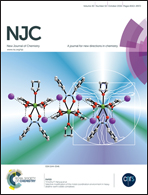New dinuclear palladium(ii) complexes with formamidine and bridged pyrophosphate ligands†
Abstract
A series of new dinuclear palladium(II) complexes of the type [(PdL1–3)2(μPPi)]·xH2O (1–3), where L = formamidine ligands and PPi = inorganic pyrophosphate, were synthesized and characterized by elemental analyses, magnetic susceptibility, UV-Vis spectroscopy, infrared (IR) spectroscopy, and mass spectroscopy, thermal analysis, and theoretical calculations. IR spectra confirmed that the formamidine ligands act as bidentate N2 ligands. The complexes are diamagnetic and analysis of the optimized structures indicated that the geometry is a distorted square planar with O–Pd–O and N–Pd–N bond angles ranging from 90.85° to 94.22° and from 87.66° to 91.43°, respectively, which are acceptable for heteroleptic complexes. The electronic energies (a.u.) of the complexes (−1246 to −1916) indicated that the complexes were stable. The energies of the HOMOs (−0.204 to −0.283) and LUMOs (−0.057 to −0.097) orbitals of the complexes were negative, which also indicated that the complexes were stable. The dipole moment of the complexes (4.14–14.08 Debye) indicated that the complexes were polarized. They were also thermally stable, as shown from their relatively higher overall activation energies (537–1002 kJ mol−1). The complexes were screened against PC-3 (prostate carcinoma cell line), HCT-116 (colon carcinoma cell line), and MCF-7 (breast carcinoma cell line). The IC50 values of the complexes were evaluated and the results showed that [(PdL1)2(μPPi)]·H2O (1) had the best IC50 value.


 Please wait while we load your content...
Please wait while we load your content...